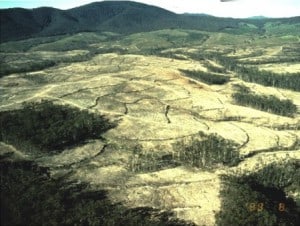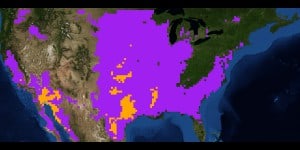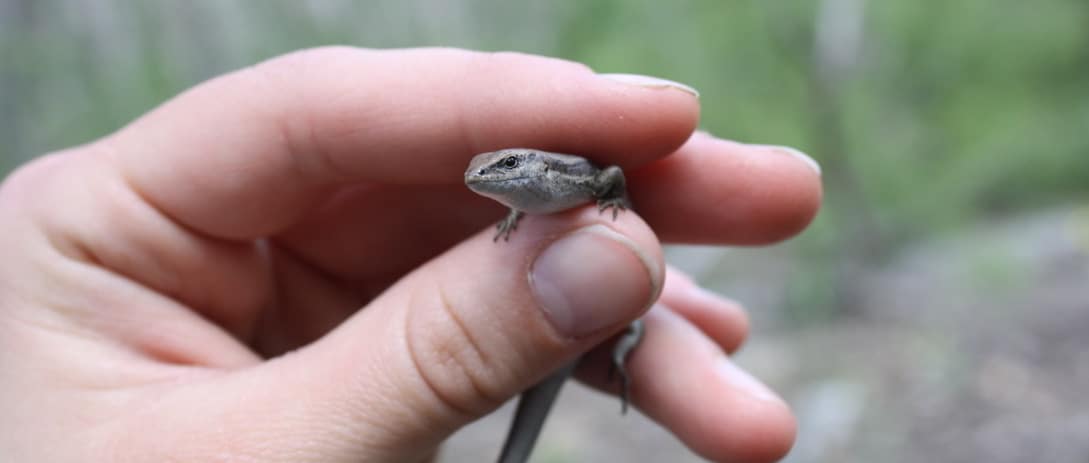Share this article
Habitat Fragmentation Causes a Hot Problem for Wildlife
The negative effect some species feel from habitat fragmentations may have more to do with temperature changes than anything else, according to ongoing studies.
In fact, temperature could explain why some species go extinct with fragmentation or deforestation in general, according to Kika Tuff, a graduate student in the ecology and evolutionary biology department at the University of Colorado Boulder. Tuff recently presented her research at the Ecological Society of America annual conference in Baltimore.
Tuff is involved with ongoing studies in the Wog Wog Habitat Fragmentation Experiment in Australia — a large area of eucalyptus trees that was intentionally fragmented in the 1980s, leaving different sized squares of native forest patches broken up by clear-cut areas. Since 2010 Tuff has been studying how common garden skinks (Lampropholis guichenoti ) responded to fragmentation, and more recently to pine plantations grown in the clear-cut patches for logging. She also had data on skinks that dated back to when the Wog Wog area was first cleared of sections of eucalyptus several decades ago.

The Wog Wog Habitat Fragmentation Experiment in Australia as it looked shortly after areas were first cleared in the 1980s. The experimental area allowed researchers to track the effects of fragmentation on different species. Image Credit: Kika Tuff
As part of her research, Tuff collected the lizards through pitfall traps set in different habitat types. The traps were equipped with thermometers to tell researchers what the temperatures were around the areas. Lizards, like many other cold-blooded animals, are very sensitive to temperature and can only operate in a certain climate window. If it gets too hot, they can die.
Tuff discovered that though fragmentation could play a role in habitat preference, the best indicator for whether the species persisted in an area was temperature. In other words, areas that were highly fragmented could still sustain a lot of lizards if they didn’t get too hot — which could occur closer to water sources, or deeper in valleys.
Tuff said that while she only looked at a certain variety of skinks, the principle could likely be applied to other species, especially cold-blooded animals in the tropics.
In fact, the reason why deforestation in places like the Amazon could have such a huge effect is that it changes the temperature for species so quickly.
“This is the biggest risk for species in the tropics — they’re so used to [thermal] stability,” she said. “Climate change is happening over a hundred years; this happens in a day.”
Aside from the species dropping in numbers, Tuff has also found that the ecology of skinks changes with the heat. In the years immediately following fragmentation, skinks in deforested areas shrunk in size, taking several years before they grew back to previous averages. Skinks also shrank in some of the smaller fragments — the smaller the patch of trees, the smaller the lizards. This could affect populations of the species overall because the smaller sizes bring competitive disadvantages for the animals.
The Climate Change Factor
While fragmentation changes the effects of temperature much more quickly than climate change, the latter could cause additional problems in the long-term in fragmented areas. Now, as the climate warms up, another study released yesterday in the Proceedings of the Royal Society B shows that extremely hot temperatures may stop some lizards from even coming out of their eggs.

A new study finds that high temperatures kill lizard embryos. Currently, three percent of land in the US is inhospitable to lizards (orange areas). In the next century, the scientists say the areas where lizards may not thrive could grow to 48 percent (purple area). Image Credit: Ofir Levy
A research team led by biologists from Arizona State University found that two plateau fence lizard species (Sceloporus undulates and Sceloporus tristichus ) embryos commonly found across the U.S. die if the temperature hits 110 degrees Fahrenheit, even for a few minutes.
“Lizards put all of their eggs in one basket, so a single heat wave can kill an entire group of eggs,” said Ofir Levy, lead investigator of the study and postdoctoral fellow with ASU School of Life Sciences. “If mothers don’t dig deeper nests to lay their eggs, we expect this species to decline throughout the United States.”
Previous studies estimated less of a problem for lizards compared to other species, but failed to take into account the fact that lizards in eggs can’t move around to find shade or escape heat.
“Because lizards are prey for animals such as birds, snakes and mammals, the harmful effects of climate change on embryonic lizards could also negatively affect other species,” Levy said.
Header Image: An ongoing study looked at the way that common garden skinks responded to habitat fragmentation and high temperatures over several decades.
Image Credit: Kika Tuff








